How to Set Up a Multi-Camera Live Streaming Webcast [2025 Update]
Today, a live-streaming webcast is an increasingly popular medium for distributing content. Used by broadcasters and businesses of all kinds, this video technology allows for incredible audience reach. And as more people move away from traditional media sources such as cable, live-stream webcasts are seeing surges in viewership.
With the increased ubiquity of webcasts, however, comes increased competition. With more broadcasters and businesses utilizing them, viewers are demanding only the highest quality. A single-camera setup won’t cut it anymore. Instead, a multiple-camera setup is the new way to go. In a multiple-camera mode with a central camera and proper camera placement, a multi-camera shoot will garner more attention. You’ll appear more professional, prove more exciting to viewers and help them keep coming back to your webcasts — but you need the right equipment.
In this article, we guide you through the multi-cam setup for live streams. We explain in more detail the benefits of a multi-camera production. We go through the hardware, software, set-up and operations. Finally, we detail other considerations to take and technical roles before concluding.
Table of Contents
- Why Stream with Multiple Cameras?
- 2025 Trends in Multi-Camera Streaming
- Challenges of Multi-Camera Streaming
- Best Multi-Camera Live Streaming Software
- Equipment Requirements for Multicam Live Streaming
- Modern Camera Connectivity: PTZ, NDI and SRT
- Set-Up and Operation for Multi-Camera Live Streaming
- Industry – Specific Setup Examples
- Other Considerations for Multi-Camera Live Streaming
- Technical Roles
- FAQs
- Conclusion
Why Stream with Multiple Cameras?
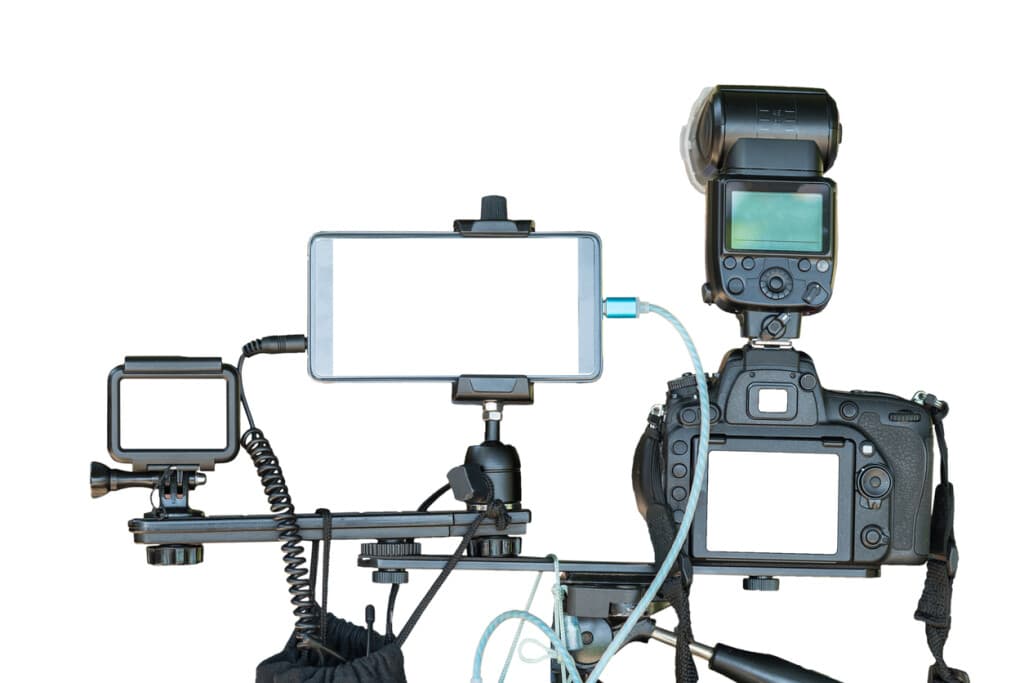

Live streaming is more than just about delivering content. No matter how engaging your content may be, you must make it visually appealing to keep your viewers entertained and interested throughout your multi-camera livestream show. The main goal of using multiple cameras to stream live is to add interest to your content and keep the audience hooked.
Think about it, what would you find more visually appealing? A single camera recording from a single angle or a more diverse mix of wide-angle shots, bird’s eye views, and tight shots of when the broadcaster is speaking to the audience?
Streaming with multiple cameras makes video content more exciting. Just look at any professional broadcast on TV or any film. The scene tends to cut between multiple angles from different sources. This setup also helps visually explain your narrative better to your audience with fewer words. Even a simple dual-camera streaming setup can significantly enhance the viewer experience.
News shows, for example, often use three cameras with the following multiple camera angles:
- A wide shot that shows the entire studio
- A medium shot that shows both hosts and their desk
- A tight shot that shows the head and shoulders of each host individually
This allows the broadcaster to switch in real-time between the different angles and views.
- The wide shot can “establish” a setting and help the viewer orient themselves.
- The medium shots are ideal for interactions between multiple people.
- And the tight shots capture the emotion and allow one person to take center stage.
This is basic cinematography. Multi-camera filming has been a staple of video production for more than 100 years for good reason. It’s simply more interesting, engaging, and generally a better way to communicate a story.
Almost any television show or movie you have ever watched uses multiple cameras to create a more immersive experience. Just looking at one static image isn’t that engaging. Online live streaming is no different.
Online live streaming is no different.
Streaming with split screens or switching between multiple camera angles is engaging. It can even be done with a single operator using fixed cameras or PTZ cameras. In fact, many streamers start with dual-camera streaming before expanding to more complex setups.
The biggest benefits of streaming with multiple cameras are:
- More engaging content
- Longer audience retention
- Less editing
Multi-camera live-streaming works well for a variety of different events, such as:
- News shows
- Tutorials
- Product reviews
- Music events and concerts
- Community events
- Live entertainment
Multi-camera live streaming is a great way to elevate your broadcasting level. It can help keep your audience more engaged and contribute to longer viewing times and increased viewership.
2025 Trends in Multi-Camera Streaming
AI-powered camera switching
In 2025, many multi camera streaming systems use AI to switch shots automatically. These smart tools follow the action and choose the best angle without a human operator. This makes it easier for creators to live stream with multiple cameras while keeping the production smooth and professional. It also helps if you’re using a dual webcam setup or want to stream multiple cameras with limited staff.
PTZ camera automation and tracking
PTZ cameras now include better auto-tracking features. You can move, zoom, and follow subjects smoothly using presets or motion tracking. This is great for church services, events, and online shows using a multi camera live streaming setup, especially when you’re working with fewer people or doing a 2 camera live stream setup.
Cloud production (e.g., Grabyo, LiveU Studio)
Cloud tools like Grabyo and LiveU Studio make it easy to control your live stream multi camera setup from anywhere. You can manage a multi camera live stream, add graphics, and switch angles without heavy gear. This also helps when you’re using live streaming software for multiple cameras or trying to livestream multiple cameras on a budget.
Remote production workflows (REMI) over 5G
Thanks to 5G, remote production is now faster and more reliable. With REMI workflows, you can stream multiple live video cameras from different locations. This is perfect for multi-camera live streaming services, especially if you’re producing events remotely or want to learn how to live stream on YouTube with multiple cameras using wireless multi camera streaming setups.
Challenges of Multi-Camera Streaming
Of course, this method of storytelling comes with particular challenges. More cameras equal more complexity. Multi-camera live streaming, using multiple streaming sources, requires linking all the different cameras to one central hub. Then, someone has to decide which shot to switch to at any one picture at any given moment during the live stream.
- More equipment: With multi-camera streaming, you need multiple cameras and cables to link the cameras to a central hub. You may also have multiple audio input sources.
- More staff: It is possible to engage in multi-camera streaming. However, a multi-camera streaming setup works best when you have a team to manage the different channels and behind-the-scenes work.
- More skills: You need more advanced skills to create a multi-camera stream. You or your team needs to understand how to set up multiple cameras for live streaming and do live video mixing.
- More data: Multiple camera streaming produces much more data. Managing, streaming, and storing all this additional data requires diligence and more computing power.
However, the advantages are worth it; this type of broadcast is getting more accessible than ever. In the past, multi-camera streaming required a significant crew and a television studio. Today, with the best live stream software, you can make a high-quality, multi-camera live stream with one person or a small team within a reasonable budget.
Best Multi-Camera Live Streaming Software
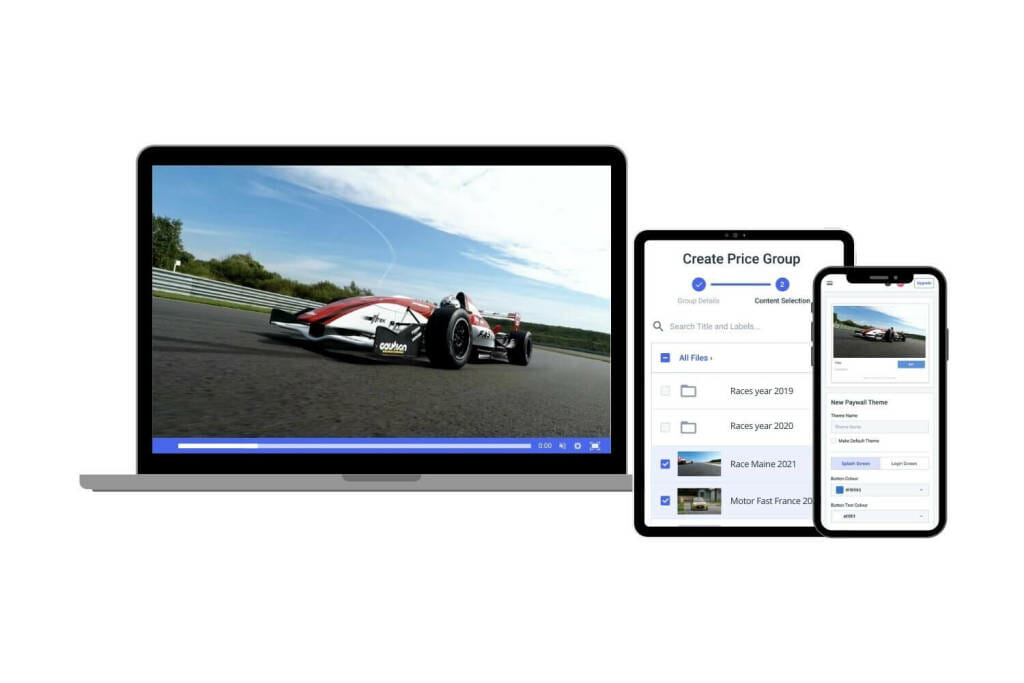

You’ll need a hardware or software encoder with an HD input to create your video stream and do secure video upload. Some viable options include live stream encoding software and hardware encoders.
These software packages are VidBlasterX, Wirecast, and OBS Studio.
1. VidBlasterX
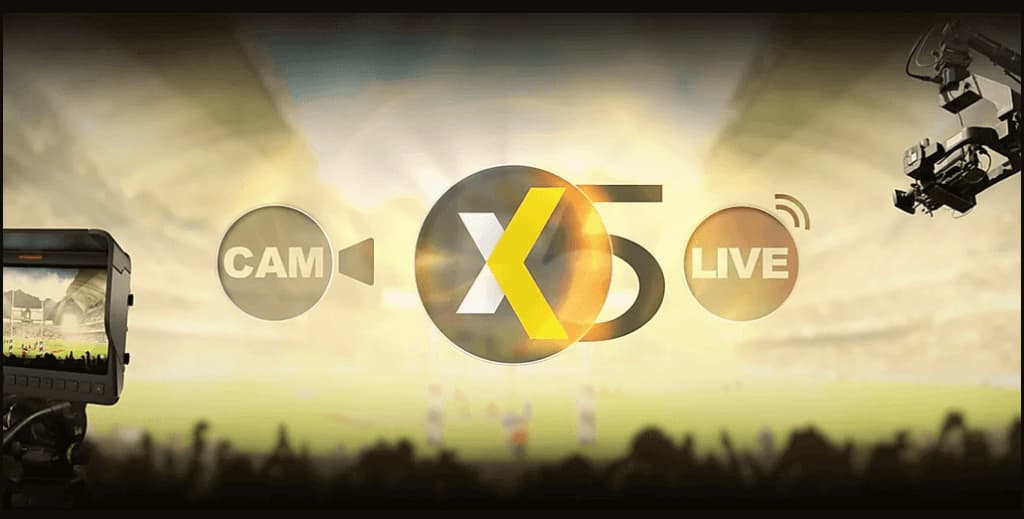

VidBlasterX is Windows-only software, and its unique modular design makes VidBlasterX highly expandable and customizable. It is one of the multi-camera live streaming software solutions on the market that you can use.
There are different versions of VidBlasterX that you can purchase and use for your multi-camera live streaming needs.
- VidBlasterX Studio has several features for the studio production of videos (hence the name) and allows for more versatile videos. The Studio version supports HD and full-screen television-quality production and community support.
- VidBlasterX Broadcast incorporates all the features of VidBlaster Studio, adds more module capacity (up to 100), and is recommended for professional broadcast studios. With Broadcast, you get direct email support from the developer.
- VidBlasterX Broadcast 4K enhances the maximum internal video resolution to UHD (4K) and supports over 100 modules per profile. Like the Broadcast version, it supports advanced audio channel mapping, as well as provides community and email support.
Basic Features:
- Live mixing tools to switch between multiple sources in real-time
- Low latency design using proprietary “SyncLok” feature
- Modular audio mixer
- Video effects and green screen support
- Custom scripting language
VidBlasterX supports multiple cameras via the camera module. More than one camera module can be added to the monitor, making it easy to switch between different cameras.
Key Features:
- Modular user interface; everything is customizable
- Includes macro and scripting functionality to automate or hot-key actions
- Supports overlays and lower thirds
- Chroma key support
- Live streaming and recording up to 4K resolution
- Compatible with social media platforms as well as most OVPs, including Dacast, with a direct integration
- Audio mixer
- Multiview support
Pros:
VidBlaster X stands out because it is a feature-rich software encoder and video production tool. It is also easy to customize the software to fit your needs. Plus, they have plans for a wide range of budgets.
Cons:
One of the biggest cons of VidBlasterX is that it isn’t compatible with macOS, so if you use an Apple computer, you will need to find a different encoder tool. It is slightly complex, making it ill-suited for inexperienced broadcasters.
Pricing:
VidBlasterX is available in three versions. Each of the following options is priced with an annual subscription model:
- Studio version ($99/year) supports 25 modules.
- Broadcast version ($999/year) supports 100 modules. This version also supports multiple recorder & streamer modules in a single profile.
- Broadcast 4K version ($4,995/year) supports 100+ modules. It adds UHD or 4K support and uses floating licenses.
The difference between the versions is the number of simultaneously active modules you can have. Higher limits allow professional users with multiple monitors to set up and oversee complex workflows.
A free (trial) edition that’s equal to the Broadcast 4K edition, but with a watermark in all output channels, is available.
2. Wirecast
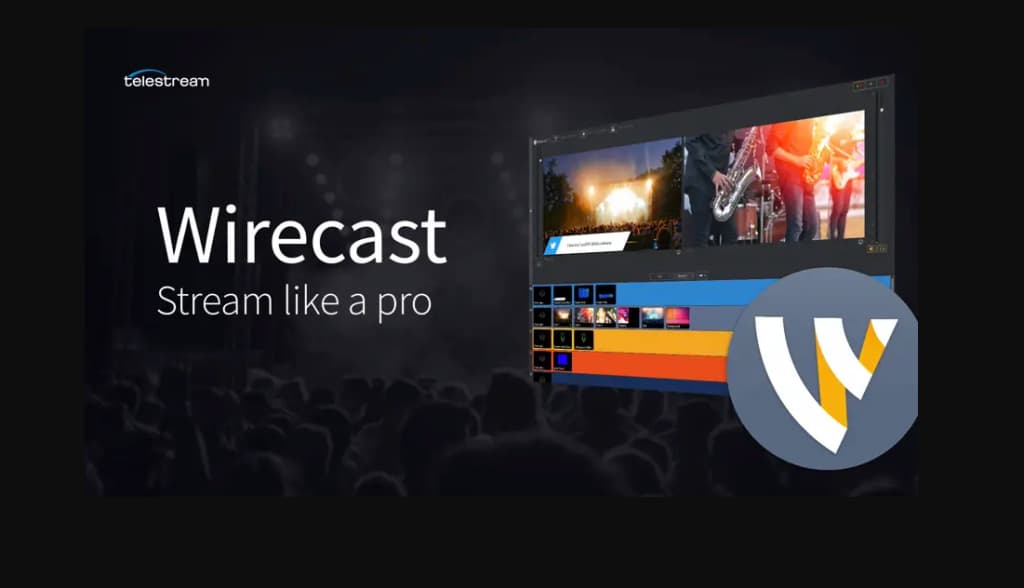

Wirecast is a powerful live streaming software available for Mac and Windows. This live-streaming software easily incorporates pre-recorded video content into your broadcast. It also supports encoding HD and SD sources for streams broadcast simultaneously to multiple servers and streaming platforms.
Basic Features:
- Support for multiple sources, including cameras, webcams, IP cameras, and NDI sources
- Screen share and videoconferencing built in
- Stream and record streams locally
- Tool for animating titles and graphics
Key Features:
- Input sources from cameras, mics, webcams, IP cameras, capture cards, and desktops
- Ideal for sports: instant replay, scoreboards, clocks, and timers
- The free wireless camera app allows you to use any iOS device as a video source
- NDI support
- Graphics and titling tool
- Audio mixer and up to 8 audio tracks
- Built-in video conference tool
- Stream to more than one destination simultaneously
- Support for MIDI hardware controllers
- Stream and record simultaneously, with re-stream and live caption options
- Multiple bitrate streaming
- Integrates with Facebook Live and Twitter for sharing comments on-screen
- Includes instant replay, scoreboard, and timers for sports
- Free wireless camera app turns iOS devices into mobile live video sources
- Stream to multiple destinations simultaneously
- Integrated video chat via “Wirecast Rendezvous”
- Local program output
The latest version of Wirecast is 16.2.2. The newest full version features several enhancements and fixes, including an AI-powered background removal video filter and PTZ virtual camera, Zoom integration, virtual assistant, and Virtual Camera improvements.
Pros:
Wirecast is a great encoding option, as it is an easy-to-use and user-friendly platform, making it great for new and experienced broadcasters. It is compatible with most operating systems, so it should work with your computer.
It is also a fully loaded program with lots of valuable features you can use to enhance the quality of your multi-camera live stream.
Cons:
The biggest drawback of Wirecast is that it has a high price point, making it a tool more for experienced users with big budgets. Also, Wirecast consumes a lot of computer memory, so you need a powerful computer to use this program.
Also, many of the best features are locked in the “Studio” version.
Pricing:
The software comes in two versions:
- Wirecast Studio for enhanced live production & streaming: pricing is $35/month or $24.92/month, billed annually. Includes 2 remote guests, NDI, screen capture, supported GPU-accelerated decoding, and more.
- Wirecast Pro for advanced live production and streaming: pricing is $46/month or $33.25/month, billed annually. Includes 7 remote guests, 1-17 slot multi-viewer output, ISO recording, PTZ camera control, and more.
Check out this document for some recommendations for using Wirecast with multiple cameras, or click here for a real-life example.
3. Restream
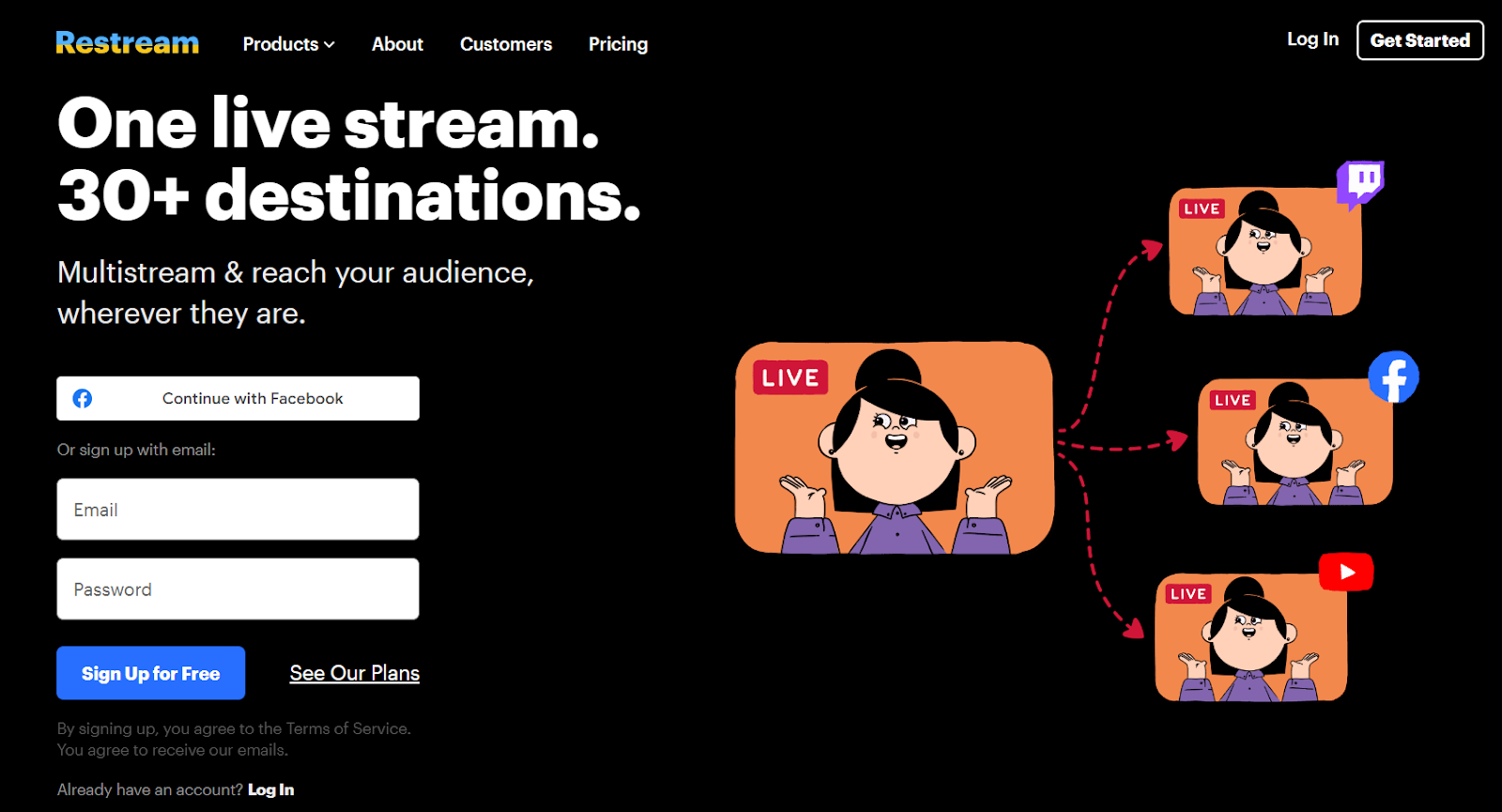

Restream is a cloud-based platform that supports both Windows and macOS. It works by connecting your cameras to your computer and then streaming the footage to the Restream servers.
From there, you can choose to broadcast your live stream to multiple platforms simultaneously, including popular social media sites like YouTube, Twitch, Facebook, and LinkedIn.
Restream offers three main products: Studio, Multistreaming, and Upload & Stream. Studio is a full-featured live streaming software, while Multistreaming allows you to stream to multiple platforms at once. Upload & Stream lets you upload and schedule pre-recorded videos to your streaming channels.
With its cloud-based architecture, Restream simplifies the process of managing a multiple-camera setup and broadcasting to diverse audiences.
Basic Features:
- Multiplatform streaming
- Live chat integration
- Analytics and performance tracking
- Customizable overlays and graphics
- Screen sharing capabilities
Key Features:
- Simultaneous streaming to 30+ platforms
- Live stream multi-camera setup support
- Real-time analytics and audience insights
- Custom RTMP destinations
- Live video editing and production tools
- Scheduled streams and uploads
- Team collaboration features
- Cloud-based video storage
- Adaptive bitrate streaming
- Multi-participant streaming (up to 10 guests)
- Brand kit and custom overlays
- Stream recording and cloud storage
- API access for advanced integrations
Pros:
Restream excels in its ability to simplify complex multi-camera live streaming setups. Its user-friendly interface makes it accessible for beginners while offering advanced features for professionals. The platform’s robust multistreaming capabilities allow content creators to maximize their reach across various social media and streaming platforms simultaneously.
Another significant advantage is Restream’s comprehensive analytics suite, which provides valuable insights into audience engagement and performance across all streaming destinations. This data-driven approach enables users to refine their content strategy and improve overall streaming quality.
Cons:
One downside of Restream is that some advanced features, such as Full HD streaming and priority support, are only available in higher-priced plans.
Additionally, the Upload and Stream allocations for Free and Standard plans are quite low, at 15-minute videos and 250 MB per video for Free, and 30-minute videos and 500 MB per video for Standard.
Pricing:
Restream offers a tiered pricing structure to accommodate various user needs, from individual streamers to large enterprises. Here’s a breakdown of its plans:
- Free: $0/month; 2 channels, 720p HD resolution
- Standard: $16/month; 3 channels, 720p HD resolution, no watermark
- Professional: $39/month; 5 channels, 1080p full HD, 10-hour recordings
- Business: $199/month; 8 channels, 3 team seats, priority support, web player
- Enterprise: Custom pricing; SSO, multiple workspaces, stream backup
Each plan progressively offers more features and capabilities, allowing users to choose the best option for their specific live streaming requirements and budget.
4. OBS Studio
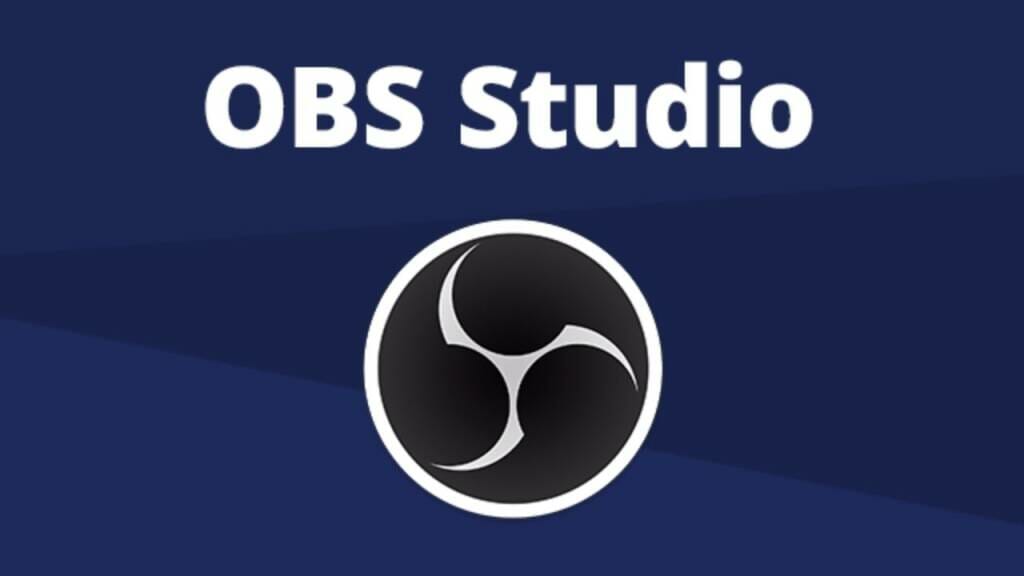

The last of the multi-camera live-streaming software options we’ll examine here is OBS Studio. OBS Studio is an open-source software application available for Windows, macOS, and Linux. OBS offers many great features for new broadcasters who are just getting the hang of live streaming. The software has a set of OBS-specific settings and system requirements to ensure the most optimal live broadcasting experience.
The latest version of the classic OBS Studio, 30.2.3, was released on August 15, 2024, and is a free download available for macOS 11.0 and newer, Windows 10 and 11, as well as Ubuntu 22.04 and newer operating systems. For the Linux version, FFmpeg is required.
Basic Features:
- Support for a wide range of sources, including cameras, audio devices, screen capture, webcams, etc.
- The “Scenes” feature allows you to preconfigure complex arrangements of graphics, video, overlays, etc.
- Audio mixing capability
- Video transitions and effects, including green screen
- Support for a wide range of plugins to add features, such as NDI support
- Modular user interface
OBS supports multiple camera sources natively. These sources (up to 8 of them) can easily be monitored via the Multiview feature. Multiview also makes it easy to see multi-camera streams and transition to any of them with a single or double click.
Key Features:
- HLS Live streaming and recording functionality
- Audio and video mixing, filters, and transitions
- Support for hotkeys
- Chroma key/green screen support
- Scenes allow you to prepare overlays in advance for rapid switching
- Support for a wide range of video, audio, and image sources, as well as screenshots
- Expandable via plugins to add NDI functionality, remote control via WebSockets, advanced scene switching, and more
- Detailed wiki and highly active user forum for support/help. Many YouTube tutorials are available as well.
Pros:
There are many reasons to use OBS Studio, with one of the most prominent being that it is free to use. Plus, OBS Studio works with most video hosting platforms, making integrating your video hosting solution easy.
OBS Studio works with Windows 10 and 11, macOS 11.0+, and Linux. It is also open-source, allowing for ongoing development and crowdsourced improvements. It is a great encoder and video production tool for beginners and advanced broadcasters.
Cons:
OBS Studio does work with macOS but only offers very basic compatibility. You can’t access all of the features on a Mac.
The program is taxing on CPU and memory, requiring a well-equipped rig to run the software. Additionally, OBS Studio doesn’t natively support multi-bitrate streaming, though you can use plugins or third-party services to achieve it.
Pricing:
OBS Studio is free to use and can be modified or extended by anyone via an API, plugins, and scripts.
To learn how to use multiple cameras for live streaming using OBS Studio, check out our dedicated guide to streaming with OBS on Dacast.
Side-by-side Comparison
Here’s a side-by-side comparison chart of popular multi camera live streaming software options including OBS, Wirecast, Restream, and vMix. This table will help you choose the right tool for your multi-camera live streaming setup in 2025.
| Software | OS Support | Price Range | AI Tools | NDI/PTZ Support | Ideal Use Case |
|---|---|---|---|---|---|
| OBS Studio | Windows, macOS, Linux | Free | Limited (via plugins) | Yes (with plugins) | Best free option for beginners and pros using a DIY multicam streaming setup |
| Wirecast | Windows, macOS | $599 – $799+ | Yes (Shot detection, replays) | Yes | Professional-grade multi camera live production for events, churches, and studios |
| Restream Studio | Browser-based | Free – $490+/yr | Basic (layouts, auto-scaling) | No | Great for streaming to multiple platforms with simple dual webcam setups |
| vMix | Windows only | $60 – $1200 (one-time) | Yes (vMix Replay, GT Title Designer) | Full NDI, PTZ supported | High-end, scalable solution for multicamera live streaming in sports, worship, and business events |
| Streamlabs | Windows, macOS | Free – $19/mo | Limited (themes, alerts) | Limited (some NDI plugins) | Ideal for creators learning how to stream multiple cameras with a user-friendly UI |
| XSplit Broadcaster | Windows only | Free – $200+ | Basic (scene control, auto-scene switcher) | Yes (NDI supported) | Great for YouTube and Twitch streamers running a 2 camera live stream setup |
Workflow: Solo Creator, Small Teams and Remote Production Setup
Here’s a handy visual breakdown of solo creator vs. small team vs. remote production setups. This will provide you with some clarity of how each position has different requirements.


Equipment Requirements for Multicam Live Streaming
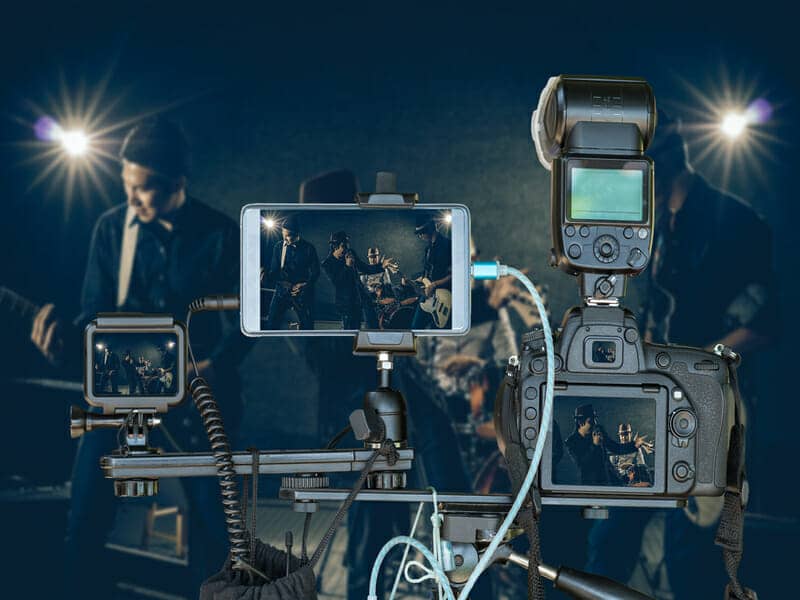

Like any professional broadcast, you’ll have to consider the live streaming equipment needs. Multicam live streaming has a few specific requirements.
We’ve already covered multi-camera live streaming software options, but let’s look at the physical equipment needed for a multi-camera set-up, including a camera, switcher, and audio equipment.
1. Camera
You will need two or more cameras for a multi-camera live streaming experience. Your chosen cameras must be equipped to shoot in HD (high definition). These days, it’s easier to acquire affordable multiple cameras that shoot at 1080i and output either an HDMI or HD-SDI signal.
It is very important to shoot in HD, even when streaming at SD (standard definition) bit rates. This is because HD sources have significantly higher visual quality than SD sources, even when encoded at lower bit rates to accommodate a diverse viewership.
For example, check out the Canon EOS C200 4K HD camcorder.
This camera has a 4K CMOS sensor, Dual DIGIC DV 6 Image Processors, an ISO range of 100 to 102, 400, dual XLR inputs, and HDMI outputs, and is compact enough for travel. Make sure to select fluid head tripods that fold up compactly enough to fit in a suitcase.
2. Switcher
Seamless switching between the various cameras is a must. In addition, the ability to add transitions, effects, and graphics is key for a multi-camera live streaming setup.
Some viable switcher options include software-based products such as Telestream’s Wirecast, which we mentioned above in our encoder review.
For hardware switchers, you might consider the Black-magic Design ATEM Television Studio or all-in-one streaming boxes such as the Livestream HD500.
3. Audio
For some events, a few wireless mics will be sufficient. More often than not, there will be a live sound system to which you can connect. We recommend bringing a small audio mixer to control the volume level of the feed you receive.
With a mixer, you can also add an ambient mic. The mic can capture the audience and venue sounds not picked up by the PA system.
Another consideration is maintaining sync between the audio and video. Typically, the video switcher introduces a delay of 2-3 frames, which means you want to delay your audio by the same duration.
Sometimes the solution involves routing the audio output of your mixer through one of your cameras. That way, the audio embeds the video inside the camera. Then, it reaches the switcher through one of the video inputs. At that point, the switcher maintains the audio/video sync. This is one way to achieve live video and audio mixing.
However, if you bring the audio directly into the encoder, note that you will need an audio delay unit to compensate for this lag.
Modern Camera Connectivity: PTZ, NDI and SRT
Today’s multi camera live streaming equipment is more flexible than ever. There are great cameras with NDI, SRT and PTZ support are making it easier for small teams to manage high-quality broadcasts. Whether you’re figuring out how to setup multiple cameras for live streaming or already comfortable with live streaming multiple cameras, understanding modern connection options is key. IP-based protocols like NDI and SRT offer smooth video transport over networks, cutting down on physical cables. These tools are essential for any multiple webcam setup or live multi camera video solution.
Overview of NDI, SRT, HDMI/SDI vs IP
NDI (Network Device Interface) lets you send high-quality video over your local network using standard Ethernet. It’s a game-changer for YouTube live stream multiple cameras or Twitch stream multiple cameras. SRT (Secure Reliable Transport) is another IP-based protocol designed for reliable streaming over less stable networks. While HDMI and SDI still offer solid connections, IP workflows are more scalable and ideal for how to use multiple cameras for live streaming.
Benefits of PTZ Cameras for Small Teams
PTZ (pan-tilt-zoom) cameras are perfect for streaming multiple cameras without needing a big crew. With remote control, one person can manage multiple angles in real time. PTZ cameras often work well with multi camera streaming software like OBS or more advanced multiple camera live stream software solutions. They’re a strong option for teams using a YouTube live stream multi camera setup or planning to go live on multiple platforms.
Budget Options That Support NDI
There are now affordable options that support NDI, including brands like OBSBOT and lower-cost PTZ models. These are great for those learning how to connect multiple cameras to OBS or seeking a simple live multi camera video solution. Budget gear still supports high-quality streams and integrates well with tools like OBS mirror camera and other streaming multi camera workflows.
PTZ and NDI Technology Integration
In 2025, PTZ (pan-tilt-zoom) cameras and NDI (Network Device Interface) technology are making it easier than ever to build a flexible, cost-effective multi camera streaming system. PTZ cameras are now smarter and more responsive, allowing producers to control multiple angles without needing extra staff. When combined with NDI, these cameras send high-quality video over a single network cable, reducing clutter and setup time.
This is especially helpful for those wondering how to stream multiple cameras without complex cabling or expensive gear. Whether you’re planning a multi camera live for church services, conferences, or online shows, PTZ and NDI offer scalable solutions that work well with live streaming software multiple cameras setups. This smart tech is changing how we live stream multi camera setups in a more affordable and simple way.
Wireless Multi-Camera Options
Wireless solutions make a big difference in any multi camera setup for events, especially when flexibility and mobility are key. Tools like the Hollyland Mars wireless video system or NDI over Wi-Fi allow you to stream from multiple cameras without running long cables. This is great for hybrid events, mobile productions, and dynamic live environments where moving freely is important.
Wireless setups also support a wide range of use cases like a 3 camera live stream setup or multi webcam setup for streaming to platforms like YouTube and Facebook. They’re easy to pair with popular multi camera live streaming software free options like OBS and Dacast. These solutions simplify multicamera live streaming, helping you build a strong multiple camera streaming setup for professional, reliable broadcasts.
Set-Up and Operation for Multi-Camera Live Streaming


To help put the scope of the multi-camera setup and operation into perspective, we will run through a live-streaming success story where a one-person crew controlled the two cameras, switcher, audio mixer, and encoder.
In this configuration, two cameras were connected to a Black-Magic Design ATEM Television Studio Switcher. The switcher was compact and affordable, with a list price of about $1000. To use it, the operator employed a laptop as an external control surface and a field HD television as a multi-view monitor.
The ATEM has 6 inputs and HDMI and HD-SDI outputs. It also featured a real-time H.264 output for recording an archive of the program stream.
The HDMI program was routed to a Matrox O2 Mini external video capture device. This device, in turn, connects to a second laptop, which acts as the encoder. A Mackie 1202 mixer receives a feed from the house PA system.
The output then went to a Behringer DEQ2496 processor. The processor delayed the audio by 2 frames. From there, it converted it to a digital AES/EDU signal for input to the ATEM switcher.
Also included in this system is a Matrox DVI converter. This conversion transcodes the screen of the host’s computer into an HD video signal that you can switch to a video source. A pair of studio headphones monitors the audio from the Mackie mixer and the encoder laptop.
Finally, the encoder laptop also serves to monitor the webcast.
Industry-Specific Setup Examples
Church
For houses of worship, a multi camera live streaming setup helps capture sermons from different angles, making the experience more engaging for online viewers. Many churches use a 3 camera live stream setup—one wide shot, one close-up on the pulpit, and another for audience reactions. A multi webcam setup with tools like OBS multiple cameras or a free multi camera live streaming software can work well, especially with a USB webcam splitter or PTZ cameras.
Fitness
Fitness instructors benefit from a multi camera streaming setup that switches between wide shots, instructor close-ups, and equipment demos. With multi camera live video production tools and a platform like Dacast, it’s easy to stream on multiple platforms at once. This makes it simple to go live on YouTube, Facebook, or Twitch with multiple cameras for streaming.
Education
Schools and online educators often use a multiple camera streaming setup to switch between the instructor, whiteboard, and shared screens. A multicam live streaming setup with OBS, paired with a solid internet connection, can handle the live stream requirements. For hybrid classrooms, a multi camera live streaming app with cloud capabilities offers flexibility for remote students.
Corporate Webinars
Companies running webinars use multi cam streaming to show both speakers and presentations. A multicamera streaming workflow using tools like OBS or Dacast allows for easy live multi camera switching. Adding IP cameras to your multicam streaming setup—or even figuring out how to connect 2 IP cameras on one cable—can help build a scalable multiple camera live stream.
Other Considerations for Multi-Camera Live Streaming
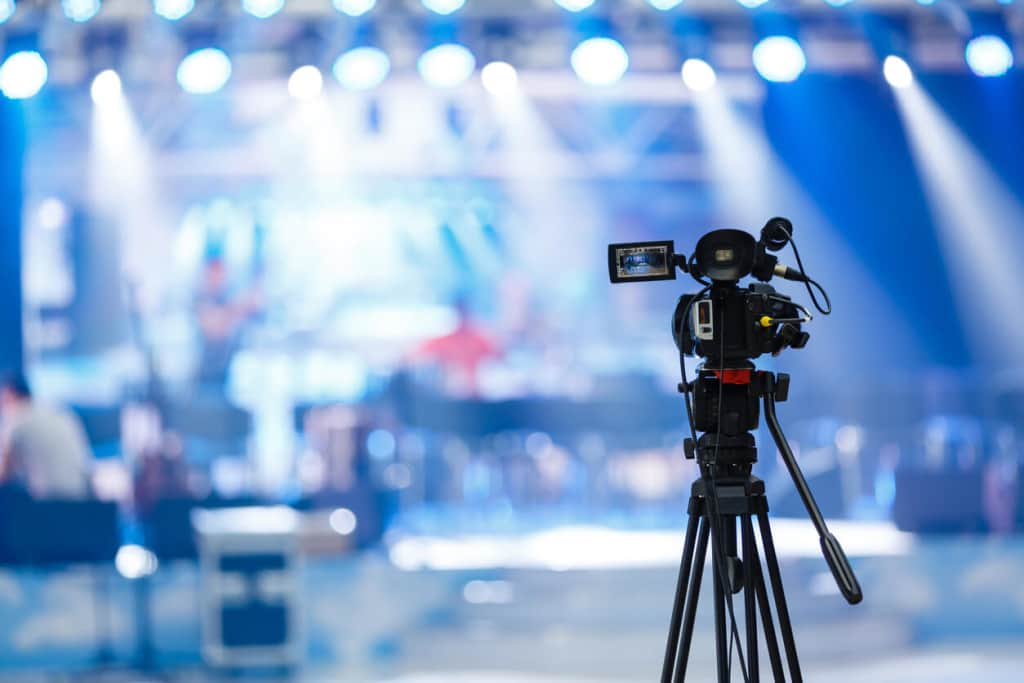

There are a few other things to keep in mind when it comes to multi-camera live streaming. The most important thing is to designate one of the multi-camera setups as your wide/master shot and the other for your close-ups.
You’ll spend most of your attention framing the close-ups. When changing angles, switch to the wide shot until your new close-up is appropriately framed. You may need to adjust your master shot from time to time. However, when you lose your close-up with multi-camera live streaming, you typically use this camera to fall back on.
The idea is to avoid panning and zooming to cover the action. It would be best if you refrained from panning unless you’re actively tracking a moving subject.
Additionally, a small multi-camera setup showing a team is ideal, but you can operate a multi-cam live stream with one person.
Audience Interaction Enhancements
Making your multi-camera live stream more interactive can turn casual viewers into loyal fans. Using overlay tools like live polls, real-time Q&A sessions, and even viewer-selected camera angles can greatly improve engagement. This is especially helpful when streaming multiple cameras for events, interviews, or live shows. Tools like OBS and OBSBOT support these features, and when integrated with platforms like Dacast, they become even more powerful.
Dacast supports a wide range of multi camera live streaming equipment and software. It works well with multiple camera live stream software solutions that offer dynamic overlays and viewer interaction tools. Whether you’re doing a Facebook live stream with multiple cameras or a YouTube live stream multi camera setup, Dacast helps keep your audience involved while streaming on multiple platforms.
Boosting Engagement in Multi-Cam Streams
One of the biggest advantages of streaming multiple cameras is the ability to keep your audience interested. By switching angles, focusing on reactions, or highlighting action from different spots, your stream feels more dynamic and less repetitive. Whether you’re learning how to live stream with multiple cameras or setting up a YouTube live stream with multi camera angles, using the right multi camera streaming software helps you tell a better story and keeps viewers watching longer.
Technical Roles
With the above context in mind, let’s take a closer look at the necessary roles and design requirements for successful multi-camera live streaming.
By nature, one-person multi-camera live streaming requires a single person to wear several distinct hats. These roles include:
- The work of 2 (or more) camera people
- Director of Programming
- Technical engineering director
- Audio engineers
- Encoding engineers
This streaming setup should be enough to get you through your first multi-camera streaming project!
FAQs
Q1. Can you stream with multiple cameras?
Yes, you can stream with multiple cameras. A multi-camera setup allows you to switch between different camera angles during your live stream, providing a more dynamic and professional experience for your audience. To live stream with multiple cameras, you’ll need a multi-camera streaming system.
Multi-camera live streaming equipment typically includes cameras, a video switcher, and multi-video streaming software. With this setup, you can create seamless transitions between camera feeds, enhancing the overall quality of your stream.
Q2. What is the best multicam streaming service?
The best multi-camera streaming software service depends on your specific needs and budget, but some popular options include OBS Studio and Wirecast. These platforms support multi-camera setups that enable live streaming with multiple cameras, as well as offer features like switching, transitions, and overlays.
Q3. What is multiview streaming?
Multiview streaming refers to the ability to simultaneously display multiple camera angles on the screen. It allows viewers to choose between different camera angles or video sources during a live stream.
This interactive feature enhances the viewing experience and is often used in sports broadcasts or concerts. It requires a robust multi-video streaming software and sufficient bandwidth.
Q4. What is the difference between single-camera setup and multi-camera setup?
A single camera setup uses one fixed camera angle, while a multi-camera setup for live streaming involves multiple cameras capturing different angles or subjects.
Multi-camera setups offer more dynamic content, allowing seamless switching between views. However, they require more expertise and equipment, such as multi-camera live streaming software, to set up and operate.
Q5. What is dual camera streaming?
Dual camera streaming is a simplified form of multi-camera live streaming that uses two cameras. This setup is popular for interviews, product demonstrations, or events where you want to show two perspectives.
Setting up dual-camera streaming involves connecting both cameras to your multi-camera streaming system and using multi-video streaming software to manage the feed, allowing for smooth transitions between the two views.
Conclusion
Using a multi-camera setup can prove to be a beneficial approach to live stream webcasting. Whether it’s via your website, broadcasting live sports events or professional content for your organization, a multi-cam setup will help increase your quality, viewer interest and base.
Using our guide, you should now feel more confident in setting yourself up with several cameras. As we mentioned and gave examples of, the software you use is of vital importance. You need a professional-grade platform with the technical capabilities and support you need to get started on the right foot.
Dacast is one such professional platform. Dacast is a complete live-streaming solution. Its white-label features mean you can create your unique brand identity for your multi-camera streaming setup. Also, you’ll have full support from our technical experts who can help get you up and running with your webcast in no time.
Ready to take your multi-camera live streaming to the next level? Dacast offers powerful tools for streaming multiple cameras, with expert technical support to guide you every step of the way. Explore our platform or request a demo to see how Dacast can simplify your multi-camera setup.
You can try Dacast’s streaming and hosting features right now with our 14-day risk-free trial.
Start for free now
Good luck with your multi-camera live streaming setup, and thanks for reading.
This article originally appeared as a part of our Tips & Tricks series, which educates readers on advanced tricks of the trade for video, and has been updated with the latest information as of April 2025.
The series comes from the expertise of outside experts in the field, and some parts of this post were written as a guest post by Gregg Hall. He joined us from Webcast and Beyond, an online video service that researches the best equipment and techniques to produce high-quality yet affordable webcasts.


